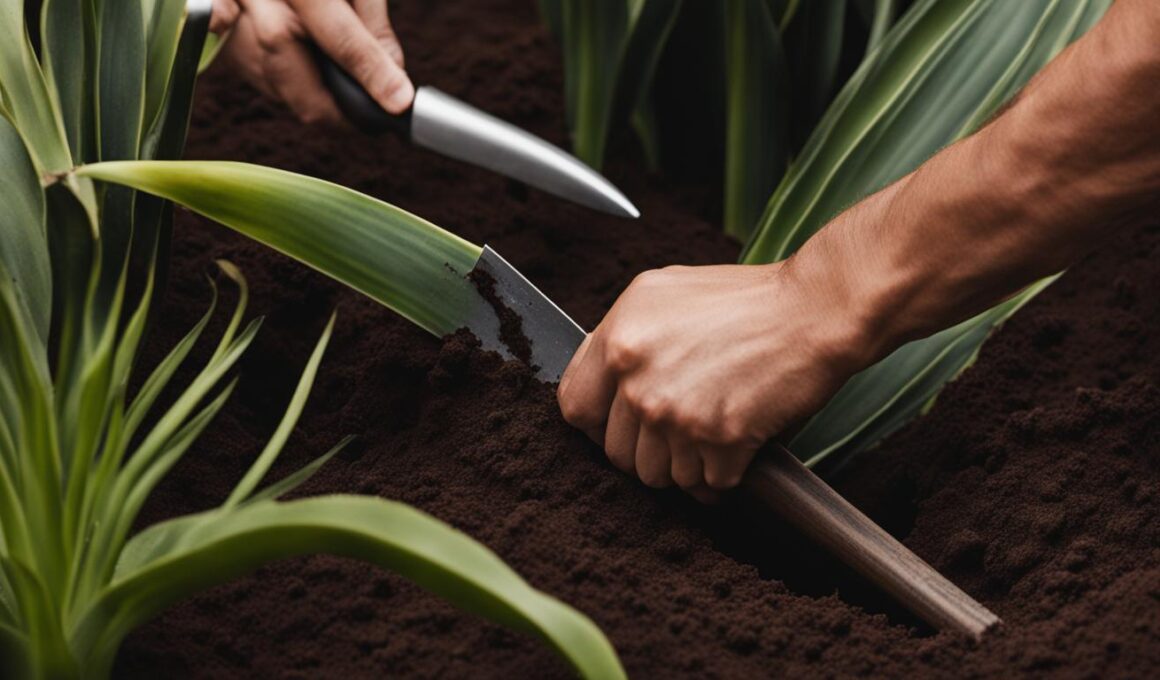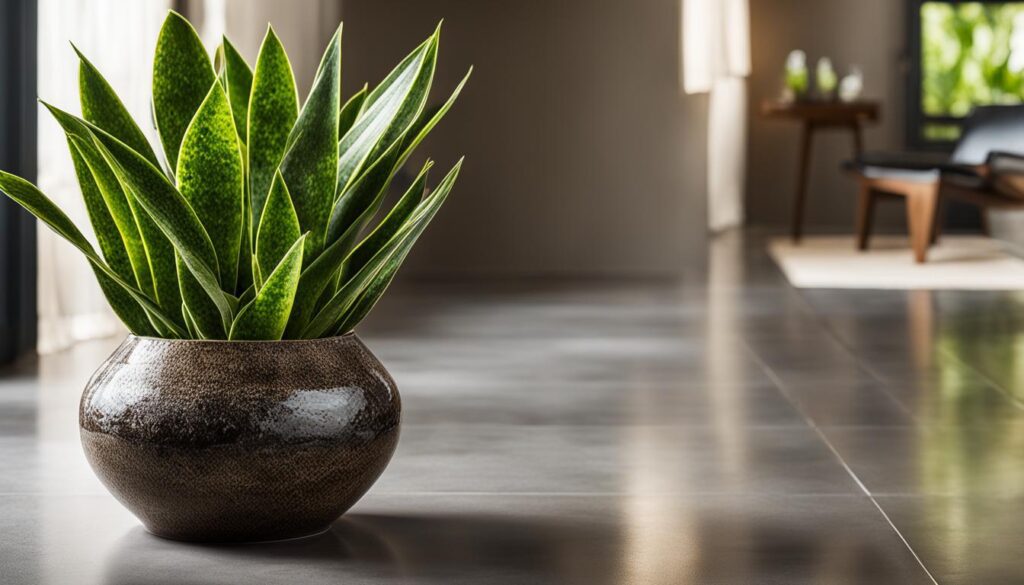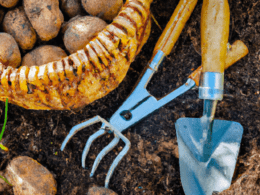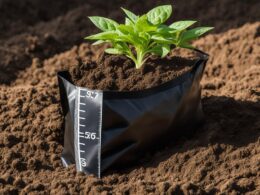Welcome to our guide on how to care for a snake plant! Also known as mother-in-law’s tongue, this easy-to-grow houseplant is perfect for beginners and busy individuals. Its hardiness and attractive sword-like leaves make it a popular choice for both home and office spaces.
Snake plants are not only beautiful but also low-maintenance. They can tolerate drought and low light conditions, making them resilient and adaptable. With their various varieties, featuring green-banded or striped leaves with yellow or cream borders, snake plants can add a touch of elegance to any indoor space.
Are you ready to learn how to care for a snake plant and watch it thrive? Let’s dive in!
Post Summary:
- Snake plants are easy to grow and perfect for beginners.
- They can tolerate drought and low light conditions.
- Snake plants come in various varieties with beautiful patterns and colors.
- They add elegance and greenery to indoor spaces.
- Snake plants are low-maintenance and resilient.
Snake Plant Propagation
One of the great things about snake plants is their ability to propagate easily, allowing you to expand your collection or share them with friends and family. There are a few different methods you can use to propagate a snake plant: division and water rooting.
Division
Dividing a snake plant is a straightforward method of propagation that involves separating the plant into smaller sections. To do this, carefully remove the plant from its pot and gently separate the root ball into sections, making sure each section has healthy roots and leaves. Then, replant each section in its own individual pot filled with cactus and succulent potting soil. This method works best in the spring or summer when the plant is actively growing.
Water Rooting
If you prefer a more hands-off approach, you can try water rooting. Start by selecting a healthy leaf from the snake plant and cut it at the base. Place the leaf in a glass of water, making sure the cut end is submerged. Change the water regularly to prevent bacterial growth. After a few weeks, you should see roots starting to form. Once the roots are about an inch long, you can transfer the cutting to a pot filled with cactus potting mix, gently covering the roots.
| Method | Best Time | Requirements |
|---|---|---|
| Division | Spring or summer | Sharp clean knife, pots, cactus and succulent potting soil |
| Water Rooting | Anytime | Glass of water, cactus potting mix |
Both division and water rooting are effective methods of propagating snake plants, so choose the one that works best for you. Remember to be patient, as it can take some time for new growth to emerge. Once your new plants are established, you can enjoy the beauty of snake plants in every corner of your home.
Snake Plant Light and Soil Requirements
Proper lighting and soil conditions are essential for the healthy growth and well-being of snake plants. Understanding the light requirements and choosing the right soil will help you provide the best care for your snake plant.
Light Requirements
Snake plants thrive in indirect sunlight, making them ideal for both bright and low-light environments. Place your snake plant in a location where it can receive 8-10 hours of indirect sunlight per day. Avoid exposing the plant to excessive direct sunlight, as it can burn the leaves and harm the plant. If your snake plant is not receiving enough light, it may not grow as well and its leaves may lose their vibrant green color.
It’s essential to find the right balance with the light exposure to ensure the optimal growth of your snake plant. If you’re placing the plant near a window, consider using sheer curtains or blinds to filter the sunlight. Alternatively, you can place the plant a few feet away from a well-lit window to provide the necessary light without direct exposure.
Soil Requirements
Snake plants require well-drained soil to prevent overwatering and root rot. A suitable soil mix for snake plants is cactus and succulent potting soil, which provides the right balance of moisture retention and drainage. Avoid using soil mixes with a high percentage of peat, as it tends to retain excessive moisture, leading to root rot.
When repotting your snake plant, make sure to use a pot with drainage holes to allow excess water to escape. This will prevent waterlogged soil and promote healthy root growth. Additionally, ensure that the pot size is appropriate for the plant, allowing room for the roots to spread comfortably.
| Lighting | Soil |
|---|---|
| Indirect sunlight for 8-10 hours a day | Well-drained cactus and succulent potting soil |
| Avoid excessive direct sunlight | Avoid high peat content in soil mix |
By providing the right amount of light and using suitable soil, you can ensure the optimal growth and health of your snake plant. Remember to monitor the lighting conditions and adjust as needed to maintain the vibrant beauty of your snake plant.
Snake Plant Watering and Temperature Needs
Proper watering and temperature control are essential for the health and growth of your snake plant. By understanding the watering schedule and providing the best temperature conditions, you can ensure that your snake plant thrives.
Watering Schedule:
- Snake plants should be watered only when the soil has completely dried out. They are drought-tolerant and can withstand periods of dryness.
- Overwatering is the quickest way to kill a snake plant, as it can lead to root rot. Avoid watering the plant if the soil is still moist.
- During the winter months, snake plants require even less water. It is usually sufficient to water them once a month.
Temperature Requirements:
Snake plants prefer warm temperatures between 70°F and 90°F (21°C to 32°C). It is essential to keep them away from cold drafts, which can harm the plant.
They can tolerate a wide range of temperatures but thrive in average household conditions. Avoid extreme temperature fluctuations and ensure that the plant is not exposed to prolonged cold or heat.
By following these watering and temperature guidelines, you can provide the optimal conditions for your snake plant, ensuring its long-term health and beauty. Remember to observe the soil moisture and adjust the watering frequency accordingly. Maintaining the right temperature range will also promote healthy growth and prevent any damage from temperature extremes.
Comparison of Watering and Temperature Needs for Snake Plants
| Topic | Watering Schedule | Temperature Requirements |
|---|---|---|
| Ideal Conditions | Water when soil is completely dry | 70°F – 90°F (21°C – 32°C) |
| Winter Care | Water once a month | Avoid exposure to cold drafts |
| Overwatering | Avoid watering if soil is still moist | Avoid exposure to prolonged heat |
Snake Plant Care and Maintenance
Proper care and maintenance are essential for keeping your snake plant healthy and thriving. In this section, we will discuss the key aspects of snake plant care, including pruning, repotting, and common pests and diseases.
Pruning
Pruning is an important part of snake plant care as it helps to maintain its shape and promote new growth. To prune your snake plant, simply remove any damaged or yellowing leaves by cutting them at the base. If your snake plant has become too tall or is outgrowing its space, you can also trim back the tallest leaves at the soil line. This will help to control the height and keep your plant looking neat and tidy.
Repotting
Snake plants typically need to be repotted every three to five years or when the roots outgrow the pot. Repotting not only provides your snake plant with fresh nutrients and soil but also gives you an opportunity to divide the plant and create new plants. When repotting your snake plant, choose a wide, shallow pot with good drainage. Gently remove the plant from its current pot, divide it if desired, and place it in the new pot with fresh cactus and succulent potting soil.
Common Pests and Diseases
| Pest/Disease | Description | Treatment |
|---|---|---|
| Scales | Small, shell-like insects that suck sap from the plant | Apply neem oil or insecticidal soap |
| Gnats | Tiny flies that lay eggs in the soil and feed on decaying organic matter | Allow the soil to dry out between waterings and use yellow sticky traps |
| Spider Mites | Microscopic pests that feed on plant sap and weave fine webs | Wipe leaves with a damp cloth and apply neem oil or insecticidal soap |
| Aphids | Small, soft-bodied insects that suck sap from the plant | Apply neem oil or insecticidal soap |
| Mealybugs | Small, white, cotton-like insects that cluster on the undersides of leaves | Remove with a cotton swab dipped in rubbing alcohol |
| Whiteflies | Small, white flies that congregate on the undersides of leaves | Apply neem oil or insecticidal soap |
Regularly inspect your snake plant for signs of pests and diseases. If you notice any of these common issues, take immediate action to prevent further damage to your plant. By following these care and maintenance tips, your snake plant will continue to thrive and bring beauty to your indoor space.
Snake Plant Troubleshooting
If you notice any issues with your snake plant, it’s important to diagnose and address the problem quickly to prevent further damage. Here are some common problems that snake plants may encounter:
Yellow Leaves on Snake Plants
Yellow leaves on a snake plant can be a sign of overwatering. When the soil becomes waterlogged, the roots can suffocate and die, causing the leaves to turn yellow. To remedy this, allow the soil to dry out completely before watering your snake plant again. Be sure to provide proper drainage and avoid watering too frequently. Trimming off any severely damaged leaves can also help the plant redirect its energy towards healthy growth.
Drooping Snake Plant Leaves
If your snake plant leaves are drooping or flopping over, it could be due to overwatering, inadequate light, or poor potting material. Make sure your snake plant is planted in well-draining soil to prevent excess moisture and root rot. Adjusting the watering frequency and ensuring the plant receives the right amount of indirect sunlight can also help resolve drooping leaves. If the plant has been in the same pot for a while, it may be time to repot it into fresh soil.
Common Problems with Snake Plants
In addition to yellow leaves and drooping foliage, snake plants can also be susceptible to common pests such as thrips. These tiny insects can cause curling leaves and can be treated with organic insecticidal soap or neem oil. Regularly inspecting your snake plant for signs of pests and promptly addressing any infestations can help keep your plant healthy and thriving.
Snake Plant Troubleshooting Table
| Problem | Possible Cause | Solution |
|---|---|---|
| Yellow Leaves | Overwatering | Allow soil to dry completely before watering |
| Drooping Leaves | Overwatering, inadequate light, or poor potting material | Adjust watering frequency, provide proper lighting, and repot if necessary |
| Common Pests | Thrips, scales, gnats, spider mites, aphids, mealybugs, whiteflies | Treat with organic insecticidal soap or neem oil |
By understanding and addressing these common problems, you can ensure your snake plant remains healthy and vibrant. Remember to provide the right amount of light, water your plant properly, and take prompt action if you notice any issues. With proper care, your snake plant will continue to thrive and bring beauty to your indoor space.
Benefits of Owning a Snake Plant
Owning a snake plant comes with a myriad of advantages that make it an ideal addition to any home or office space. Whether you’re a seasoned plant enthusiast or just starting out on your green thumb journey, here are some compelling reasons to have a snake plant:
- Air purification: According to NASA research, snake plants have air-purifying capabilities. They can effectively remove toxins such as formaldehyde and benzene from the air, making your indoor environment healthier and fresher.
- Low maintenance: Snake plants are renowned for their ability to thrive with minimal care. They can tolerate low light conditions, making them perfect for spaces with limited natural sunlight. Additionally, they have a drought-resistant nature, meaning you won’t need to water them frequently. This makes them an excellent choice for busy individuals or those who may forget to water their plants regularly.
- Easy propagation: Snake plants can be easily propagated through division or water rooting. This means you can expand your plant collection or share the joy of owning a snake plant with friends and family.
- Stylish aesthetic: With their tall and upright leaves, snake plants bring a touch of elegance to any room. They add height and interest to plant collections and can serve as a focal point in your decor.
Overall, owning a snake plant offers a combination of aesthetic appeal, air purification, and minimal maintenance. It’s a versatile plant that adds beauty, health benefits, and a touch of greenery to your indoor space. Whether you’re a busy individual or a plant lover looking to expand your collection, a snake plant is a wonderful choice that will thrive in various conditions.
Conclusion
Growing a snake plant is a rewarding experience as they are easy to care for and can last for many years. By following the proper care guidelines, such as providing the right amount of light, watering correctly, and troubleshooting any issues that arise, you can enjoy the beauty and benefits of a snake plant in your home.
Snake plants are a practical choice for beginners and busy individuals due to their low maintenance nature. They are almost indestructible, making them a great first plant and a perfect fit for anyone with a busy lifestyle. Their unique shape adds height and interest to any plant collection, and they are adaptable to various light conditions, including low-light environments.
Aside from their aesthetics, snake plants have air-purifying capabilities, according to NASA research. They can add a touch of greenery to small spaces, and their drought-resistant nature makes them suitable for those who tend to forget to water their plants. So, unleash your green thumb and start growing your own snake plant today!
What Are Some Similar Care Tips for Growing Snake Plants and Daffodils?
When it comes to planting and caring for daffodils and snake plants, there are some similar tips to keep in mind. Both plants prefer well-draining soil and can tolerate dry conditions. It’s essential to avoid overwatering, as excessive moisture can lead to root rot for both daffodils and snake plants.
FAQ
How often should I water my snake plant?
Snake plants should be watered only when the soil has completely dried out. Overwatering can cause root rot, so it’s best to err on the side of underwatering rather than overwatering.
How much light does a snake plant need?
Snake plants prefer indirect sunlight for around 8-10 hours a day or a few hours of early morning direct sunlight. Too much direct sun can burn the plant, while too little light can stunt its growth.
Can snake plants be propagated?
Yes, snake plants can be propagated through cuttings or division. In spring or summer, you can divide the plant with a sharp knife, keeping the roots intact for each section, and replant them in new pots. Another method is water rooting, where a healthy leaf is cut and submerged in water until roots develop, and then potted in soil.
What kind of soil is best for snake plants?
Snake plants thrive in well-drained sandy soil and do well in cactus potting soil. It is important to avoid soil mixes with a high percentage of peat, as they can retain too much water and cause root rot.
How do I know if my snake plant is getting too much water?
Overwatering can cause yellow or brown leaves. If the soil feels consistently wet or the leaves become mushy, it’s a sign of overwatering. Allow the soil to dry out completely before watering again.
How do I prune my snake plant?
During the growing season, you can prune your snake plant to encourage new growth. Tallest leaves can be removed at the soil line to control its height.
Are snake plants toxic to pets?
Yes, snake plants are toxic to cats and dogs. Keep them out of their reach to avoid any potential harm.
What are the benefits of owning a snake plant?
Snake plants are low maintenance, adaptable to different light conditions, and have air-purifying capabilities. They are also great for beginners and busy individuals, as they are almost indestructible.










